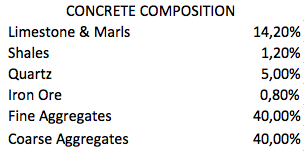World Mining for Renewables Figures Collection (4 of 20): Mineral & Metal Resources for Wind Energy Marketplace
This post is the fifth edition of a 20 posts collection with global data to explain the relationship of Solar PV and Wind Energy world markets with the mining industry (extractive industries). We will check the production of metals, industrial and construction minerals to build solar modules and windmills around the world. In the end of the article, you can find the links to the other four articles of the collection.
In the next 5 years (2018 - 2022), the Wind Energy marketplace will require about 300 million tones of minerals and metals
Main Results
In the following article, we will analyze specific metals and industrial minerals, however, in the present article, we are focused on the requirements for major families of minerals to build world wind energy facilities.
Tones of Materials
In the next 5 years (2018 – 2022), the Wind Energy marketplace will require 297.51 million tones of minerals and metals:
- 145.46 million tons of Aggregates (included in the concrete installations supporting windmills) meaning close to the 48% of total extractive industry materials.
- 37.7 million tons of Industrial Minerals, meaning the 12.5% of total extractive industry materials.
- 77.85 million tones of Metals, meaning the 25.64% of total extractive industry materials.
- 42.17 million tones for energy minerals (mainly metallurgical coal), meaning the 13.91% of total extractive industry materials.

Market Size
Based on November 2017 market commodity prices, the size of the market 2018 – 2022 (both included) will reach the 36,643 USD million:
- 5,964 USD million for Aggregates (16.28% of total value extractive industry products)
- 1,995 USD million for Industrial Minerals (5.44% of total value extractive industry products)
- 22,501 USD million for Metals (61.41% of total value extractive industry products)
- 6,183 USD million for Energy Minerals (16.87% of total value extractive industry products)
Market trends 2015 – 2022
In the following image you can observe the trend of mineral and metal consumption for the World Wind Energy market in the period 2015 to 2022:
- Aggregates: 23 (2015) up to 32 (2022) million Tones
- Industrial Minerals: 6 (2015) up to 8.33 (2022) million Tones
- Metals: 12.83 (2015) up to 17.12 (2022) million Tones
- Energy Minerals: 6.67 (2015) up to 9.28 (2022) million Tones
- Total Mining: 47 (2015) up to 65.5 (2022) million Tones
- Total Mining & Oil: 48 (2015) up to 66.76 (2022) million Tones

Methodology for Calculation
1. Determination of composition for Wind Energy material Components
Following two images, source IRENA 2017 data and Vestas 2015, we build an equivalent matrix between tonnes of minerals and metals with MWp for solar and wind energy facilities. Plastics are included in the division of «oil derived products»,
Wind Energy Materials composition

Solar PV Materials composition

The market for minerals and metals to produce Solar PV facilities (2018-2022) will reach the 36,643 USD millions
2. Determination of Energy for major common materials,
Energy, including fuel and electricity, for major materials involving the needs for minerals and metals, is a complex subject for discussion. We have to include not only the energy requirements for mining but also to transform into other products as metals or glass. We use the following source of information to determine the energy to take (on average) to produce 1 kilogram of the following materials in Lower Tech Magazine.
A. Involving Ferrous Metals
- Steel (from recycled steel): 6-15MJ (1,665 to 4,170 watt-hours)
- Steel (from iron): 20-50MJ (5,550 to 13,900 watt-hours)
- Iron (from iron ore): 20-25MJ (5,550 to 6,950 watt-hours)
- The composition of Steel:
- Ratio Iron Ore to Steel: 1.25
- Ratio Metallurgical Coal to Steel: 0.625
B. Involving Base Metals
- Aluminum (from 100 % recycled aluminum): 11.35-17MJ (3,150 to 4,750 watt-hours)
- Aluminum (from a typical mix of 80% virgin and 20% recycled aluminum): 219 MJ (60,800 watt-hours)
- Aluminum (from bauxite): 227-342MJ (63,000 to 95,000 watt-hours)
- Nickel (from ore concentrate): 230-270MJ (63,900 to 75,000 watt-hours)
- Copper (from sulfide ore): 60-125MJ (16,600 to 34,700 watt-hours)
C. Involving Precious Metals
- The approach for Silver is made following the data of The Silver Institute. About 10% of global application of Silver deals to the Solar PV modules as Ross Beaty confirmed in the conference of Mines & Money Americas last October 2017.
D. Involving Industrial Minerals
- Silicon (from silica): 230-235MJ (63,900 to 65,300 watt-hours)
- Electronic grade silicon (CVD process): 7,590-7,755MJ (2,108,700 to 2,154,900 watt-hours).
- Glass (from sand, etcetera): 18-35MJ (5,000 to 9,700 watt-hours). Quartz is
- Plastics (from crude oil): 62-108MJ (17,200 to 31,950 watt-hours)
- Titanium (from ore concentrate): 900-940MJ (250,000 to 261,000 watt-hours)
E. Involving Construction and Industrial Minerals
- Composition of Concrete, Glass, and Fiberglass



3. Balance previous data with Solar PV and Wind Energy market facilities
We adjust the precedent data with Solar PV and Wind Energy market data. Sourcing:
- Wind Energy Market data: World Wind Energy Association 2016 and 2017
- Solar PV Data: GTM Research 2017
Previous Posts
World Mining for Renewables (1 of 20): The Solar PV Market
World Mining for Renewables (2 of 20): The Wind Energy Market
World Mining for Renewables (3 of 20): The Solar PV & Wind Energy Markets
World Mining for Renewables (4 of 20): Mineral & Metal Resources for Solar PV Marketplace
Next Post (5 of 20)
Under next article, we will analyze the demands for Mineral & Metal Resources for Solar & Wind Energy Marketplace.
LinkedIn Group: Renewable Energy for Mining and Oil:
If you are interesting about these topics (Renewable Energies, Energy Storage, Electric Vehicles), please you are welcome to participate in the LinkedIn group about





